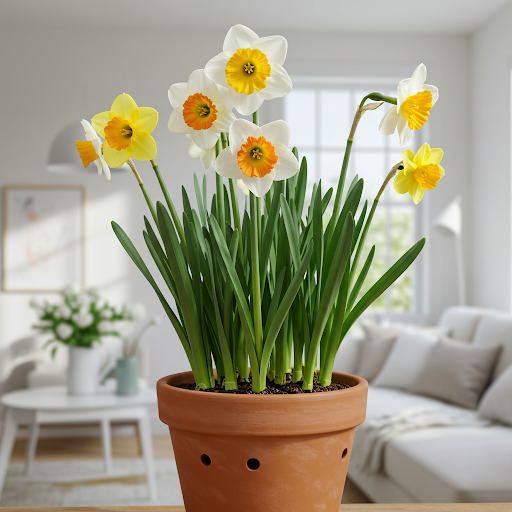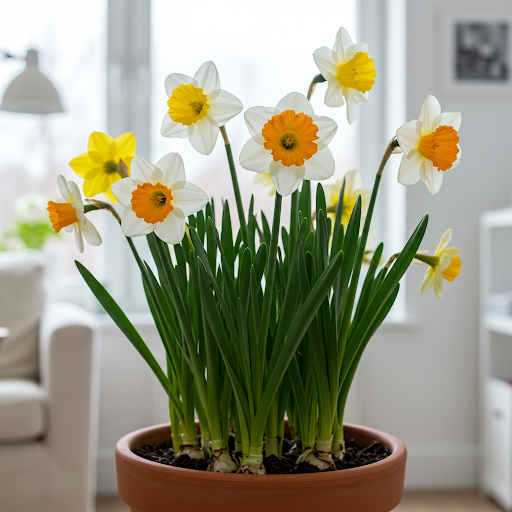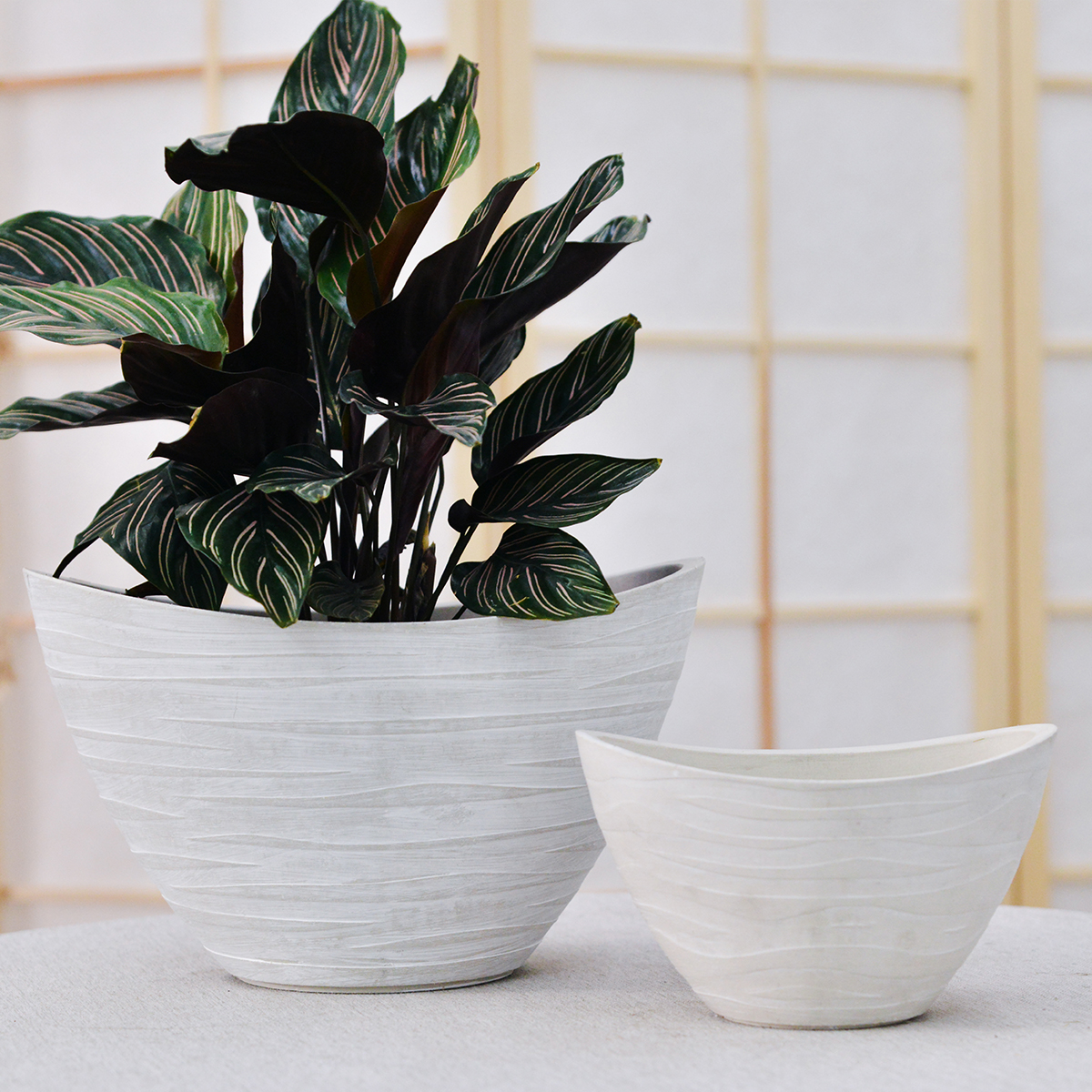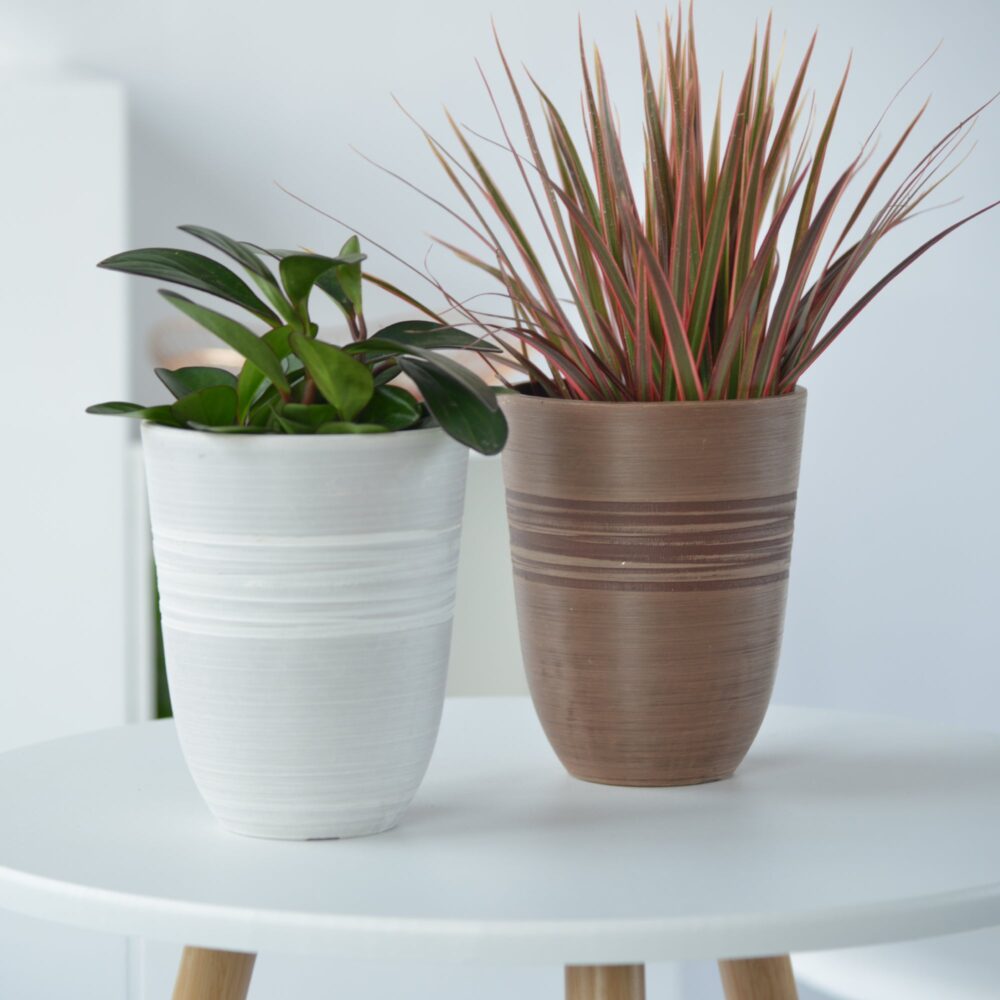Daffodils Indoors: The Complete Guide to Growing Narcissus at Home
Looking to infuse your home with the cheerful spirit of spring and delicate fragrance during the winter months? Daffodils, scientifically known as Narcissus, are iconic spring-blooming bulbs celebrated for their trumpet-shaped flowers and sunny disposition. These classic and relatively easy-to-force bulbs, native to meadows and woodlands of Europe and North Africa, are perfect for bringing the joy of spring indoors during the colder seasons. This comprehensive guide will provide you with everything you need to know to grow Narcissus indoors, from selecting the right bulbs and pots to mastering essential forcing techniques for a bright and fragrant indoor Daffodil display in your home.

Daffodils
What are Daffodils (Narcissus)?
Narcissus, commonly known as Daffodil, Jonquil, or Narcissus, is a genus of predominantly spring flowering perennial herbaceous bulbous geophytes in the Amaryllidaceae family. Daffodils are beloved for their distinctive trumpet or cup-shaped corona surrounded by six petal-like tepals. They are celebrated for their sunny colors, predominantly shades of yellow, white, orange, and pink, with many bi-colored and fragrant varieties. Flower shapes vary from classic trumpets to doubles, split-corona, and poeticus types. They are relatively short to medium-height plants, typically ranging from under 6 inches to over 2 feet tall depending on the variety. Daffodils are prized for their cheerful colors, elegant flower shapes, often delightful fragrance, and ease of forcing indoors, making them a quintessential symbol of spring and a popular choice for indoor blooms.
Can Daffodils (Narcissus) Thrive Indoors?
Yes, Daffodils (Narcissus) are very well-suited for indoor growing, especially for forcing blooms during the winter months to enjoy their spring beauty and fragrance indoors. Daffodils are excellent candidates for “forcing,” which involves simulating winter conditions to encourage them to bloom out of their natural spring season. Many daffodil varieties, particularly paperwhites, tazetta daffodils, and some early trumpet and small-cupped daffodils, are reliable for indoor blooms. Growing daffodils indoors allows you to experience their cheerful colors and delicate fragrance up close, bringing a touch of springtime warmth and brightness to your home during the darker winter months.
Ideal Indoor Growing Conditions for Daffodils (Narcissus):
- Varieties of Daffodils (Narcissus) for Forcing: While many daffodils can be forced, certain types are more reliable and fragrant for indoor growing. Ideal daffodil varieties for indoor forcing include:
- Paperwhite Daffodils (Narcissus papyraceus): ‘Ziva’, ‘Paperwhites Grandiflorus’. These are exceptionally fragrant, pure white, and very easy to force in water or pebbles, requiring little to no chilling.
- Tazetta Daffodils (Narcissus tazetta): ‘Avalanche’, ‘Cragford’, ‘Geranium’, ‘Minnow’, ‘Bridal Crown’. These are fragrant, often multi-flowering, and force well in soil or pebbles, often needing minimal chilling.
- Jonquilla Daffodils (Narcissus jonquilla and hybrids): ‘Bell Song’, ‘Step Forward’, ‘Quail’. These are fragrant, multi-flowering, and generally force well with chilling.
- Early Trumpet Daffodils (some varieties): ‘Rijnveld’s Early Sensation’, ‘February Gold’. Choose early blooming and shorter trumpet types for better forcing success.
- Small-Cupped Daffodils (some varieties): ‘Barrett Browning’, ‘Sabrosa’. Select early and compact varieties. Avoid large trumpet daffodils and late-blooming varieties for indoor forcing, as they may require more chilling and become too tall and leggy indoors.
- Light: For forcing, light is not critical during the chilling period. After the chilling period and when shoots emerge, Daffodils need bright, indirect light to develop strong stems and vibrant flowers. Place them in a location that receives bright, filtered sunlight or indirect light. East, south, or west-facing windows are suitable once they are brought out of chilling. Rotating the pot regularly will help ensure even growth and prevent stems from leaning towards the light. Insufficient light can lead to weak, leggy stems and pale flowers. Paperwhites and Tazetta types are more tolerant of slightly lower light conditions than some other daffodil types.
- Soil (for forcing in soil): When forcing daffodils in soil, use a well-draining potting mix. A general-purpose potting mix amended with perlite or vermiculite to improve drainage is suitable. The soil should be slightly acidic to neutral.
- Watering: During the chilling period, keep the soil barely moist. Once the bulbs are brought into warmer temperatures and shoots emerge, water moderately to keep the soil consistently moist, but not soggy. Water when the top inch of soil begins to feel slightly dry. Water thoroughly until water drains out of the drainage holes. Avoid overwatering and soggy soil, which can lead to bulb rot. Reduce watering slightly after flowering as the foliage begins to fade. For paperwhites and tazetta daffodils forced in pebbles and water, maintain the water level consistently. Watering frequency will depend on temperature, humidity, and pot size. Check soil moisture regularly. Use room temperature water.
- Temperature: Chilling Period (for most daffodils, except Paperwhites and Tazettas): Most daffodil varieties (excluding Paperwhites and Tazettas, which may need little to no chilling) benefit from a cold chilling period of 10-15 weeks at temperatures between 35°F to 45°F (2°C to 7°C) to initiate flower development. Check specific chilling needs for your chosen variety. Chilling is less critical or minimal for Paperwhites and Tazetta types. Ideal chilling locations include:
- Refrigerator: The vegetable crisper drawer of a refrigerator (avoid storing near fruits, as ethylene gas can inhibit flowering).
- Unheated Garage or Basement: If temperatures remain consistently within the required range.
- Outdoor Cold Frame: In regions with mild winters.
- Cool, Dark Location: A cool, dark room or closet can work if temperatures are consistently cold enough.Growing/Forcing Period (After Chilling): After chilling (if required), bring the daffodils to a cool room (50-60°F/10-15°C) with indirect light to gradually transition them to warmer temperatures and brighter light. Once shoots are a few inches tall, move them to a bright location with slightly warmer temperatures (60-70°F/15-21°C) to encourage flowering. Avoid placing them near heat sources, which can shorten bloom time. Cooler temperatures will prolong the flowering period and enhance flower color. Paperwhites and Tazettas can tolerate slightly warmer forcing temperatures.
- Humidity: Daffodils are not particularly demanding regarding humidity. Average household humidity is generally sufficient.
Planting and Forcing Daffodils (Narcissus) Indoors:
- Selecting Bulbs for Forcing: Choose large, firm, and healthy daffodil bulbs specifically recommended or labeled for “forcing”. Forcing bulbs have been pre-cooled to enhance their ability to bloom indoors. Purchase bulbs in the fall for winter forcing. Select early to mid-season blooming types, and consider Paperwhites or Tazettas for no-chill forcing.
- Planting Time for Winter/Early Spring Blooms: Plant daffodil bulbs for forcing in fall (September to December) to enjoy blooms in winter or early spring (December to April), depending on the variety, chilling duration, and desired bloom time.
- Planting Methods for Forcing: Daffodils can be forced in soil or water (using pebbles or gravel). Paperwhites and Tazettas are especially well-suited for forcing in water.
- Forcing in Soil (General Daffodils):
- Choose Pots: Select pots with drainage holes (terracotta, ceramic, or plastic). Wider, shallower pots are often ideal for daffodils.
- Fill with Potting Mix: Fill pots with well-draining potting mix, leaving space at the top.
- Plant Bulbs: Place daffodil bulbs pointed-end up on the soil surface, close together but not touching, typically 3-5 or more bulbs per 6-8 inch pot, depending on bulb size and pot width. Plant bulbs more densely than you would in the garden. The bulb’s tips should be just above the soil surface or slightly protruding.
- Water Lightly: Water lightly to settle the soil around the bulbs.
- Chilling Period (if needed): Place planted pots in a dark, cold location (35-45°F/2-7°C, or as per variety needs) for 10-15 weeks (or as recommended for variety) for chilling. Keep soil barely moist during chilling. Label pots with variety and planting date.
- Bring Out of Chilling: After the required chilling period, when shoots are about 1-2 inches tall and roots are visible at the drainage holes, bring pots to a cool room (50-60°F/10-15°C) with indirect light.
- Increase Light and Temperature: Gradually move to a bright location with slightly warmer temperatures (60-70°F/15-21°C) to encourage flowering.
- Forcing in Water/Pebbles (Paperwhites, Tazettas, some others):
- Vase or Container: Use a vase or container without drainage holes. Clear glass vases are attractive for showcasing roots.
- Pebbles/Gravel: Fill the bottom portion of the vase with pebbles, gravel, or marbles to about 2-3 inches deep for bulb support.
- Water Level: Add water to just below the level of the pebbles, so the bulb base will sit just above the water, not in it (this prevents rot).
- Place Bulbs: Place daffodil bulbs pointed-end up on top of the pebbles, close together.
- Chilling Period (usually minimal or none for Paperwhites/Tazettas): For Paperwhites and Tazettas, chilling is often not required or minimal (a week or two in a cool, dark place can be beneficial but not essential). For other daffodil types, follow chilling recommendations.
- Bring to Light and Warmer Temperatures: Move vases to a bright location with slightly warmer temperatures (60-70°F/15-21°C) to encourage flowering.
- Forcing in Soil (General Daffodils):
Choosing the Right Pots for Indoor Daffodils (Narcissus):
- Suitable Pot Types (for soil forcing): Select pots with drainage holes. Terracotta, ceramic, or plastic pots are all suitable. Wider, shallower pots like bulb pans or azalea pots are often preferred for daffodils as they are typically planted more densely for forcing.
- Drainage (for soil forcing): Drainage is essential to prevent bulb rot. Ensure your chosen pot has drainage holesat the bottom.
- Pot Size (for soil forcing): Choose pot size based on the number of bulbs you want to plant together. For a cluster of 5-7 bulbs, use a pot that is 8-10 inches in diameter. For smaller groupings, adjust pot size accordingly. Allow enough depth for roots to grow below the bulbs (at least 4-6 inches deep pots).
- Vases/Containers (for water forcing): Use vases or containers that can hold water and pebbles or gravel for bulb support. Clear glass vases are attractive for water forcing. Drainage is not needed for water forcing, but stability is important, especially for taller varieties.
Essential Care Tips for Thriving Indoor Daffodils (Narcissus):
- Chilling Period (if needed) is Important: Ensure a proper chilling period (if required for your variety) at recommended temperatures and duration in darkness for successful forcing and flowering. Monitor temperature and chilling duration carefully. Paperwhites and Tazettas are exceptions and often require minimal chilling.
- Watering Schedule (after chilling): “Keep Soil Moist, Not Soggy”. For soil-forced daffodils, water moderately to keep soil consistently moist once shoots emerge. For water-forced daffodils, maintain water level just below the bulb base. Avoid overwatering in both methods.
- Light Management (after chilling): Bright Indirect Light for Strong Growth. After chilling, provide bright, indirect light once shoots emerge to encourage strong stems and vibrant flowers. Rotate pots regularly for even growth.
- Fertilizing (Not Usually Needed for Forcing): Fertilizing is generally not necessary for forcing daffodils as they contain enough stored energy in the bulb to bloom for one season.
- Support for Tall Stems (Often Needed): Many daffodil varieties, especially taller ones, will require staking or support to prevent flower heads from becoming too heavy and stems from bending or breaking. Use plant stakes, hoops, or twiggy branches to support stems as they grow taller. For Paperwhites forced in water, “forcing” with a diluted alcohol solution (like gin or vodka diluted with water) after roots are established can help reduce stem height and prevent flopping (use about 4-6% alcohol solution).
- Pest and Disease Control: Indoor daffodils are generally less prone to pests and diseases than garden daffodils. Monitor for aphids or bulb mites occasionally. Bulb rot can occur if overwatered, especially during chilling or forcing in overly wet conditions. Ensure good drainage and avoid overwatering.
- After Flowering: After daffodil flowers fade, they will not rebloom indoors in the same season. You can cut off the spent flower heads to prevent seed formation, but allow the foliage to continue growing until it naturally yellows and withers. This allows the bulb to replenish some energy.
- Planting Outdoors (Optional, after forcing): Forced daffodil bulbs can be planted outdoors in the garden in spring after the foliage has died back. However, forced daffodil bulbs are often depleted of energy and may not rebloom reliably outdoors in subsequent years, especially for forcing varieties. They are often treated as annuals after forcing. If planted outdoors, they may take a year or two to re-establish and potentially bloom again, and blooms may be smaller or less vigorous. For best results, it is often recommended to discard forced daffodil bulbs after flowering and start with fresh bulbs each fall for indoor forcing, especially for optimal indoor displays. Paperwhites are generally not hardy in colder climates and are best discarded after forcing.
- Toxicity: Daffodil bulbs are toxic if ingested and can cause skin irritation in some individuals. Wear gloves when handling bulbs and keep them out of reach of children and pets.
Popular Daffodil Cultivars for Indoor Forcing (by Color & Type):
- White Paperwhites: ‘Ziva’, ‘Paperwhites Grandiflorus’
- White Tazettas: ‘Avalanche’, ‘Bridal Crown’, ‘Inbal’
- Yellow Tazettas: ‘Cragford’, ‘Soleil d’Or’, ‘Golden Dawn’
- Bi-color Tazettas: ‘Geranium’, ‘Minnow’, ‘Martinette’
- Yellow Jonquillas: ‘Bell Song’, ‘Step Forward’, ‘Quail’, ‘Sun Disc’
- Yellow Trumpets (Early): ‘Rijnveld’s Early Sensation’, ‘February Gold’
- Orange/Red Cup (Small-Cupped): ‘Barrett Browning’, ‘Sabrosa’, ‘Verona’

Daffodils
In Summary:
Growing Daffodils (Narcissus) indoors through forcing is a delightful way to bring the cheerful colors, delicate fragrance, and sunny spirit of spring into your home during the winter months. Their diverse types and ease of forcing (especially Paperwhites and Tazettas) make them cherished winter houseplants. By selecting appropriate varieties, providing a proper chilling period (if needed), planting bulbs in well-draining soil or forcing containers with pebbles, watering appropriately, providing bright, indirect light after chilling, and offering support as needed, you can easily cultivate bright and fragrant indoor Daffodils and enjoy their cheerful blooms and springtime charm during the coldest months of the year.
For more detailed botanical information and to explore the diversity of the Narcissus genus, you can visit the Wikipedia page on Narcissus.
Important Note: Daffodil bulbs are toxic if ingested and can cause skin irritation. Handle bulbs with gloves and keep them away from children and pets. Enjoy the beauty and fragrance of your indoor daffodils, and be aware that forced bulbs are often best treated as annuals for optimal indoor displays, though outdoor planting after forcing may yield some future blooms in the garden, depending on the variety and your climate.
k2-21G
By greenship|2024-08-13T06:17:26+00:00August 13, 2024|Categories: Hand-carving Series|
20YB
By greenship|2024-08-16T05:37:57+00:00August 16, 2024|Categories: Hand-carving Series|
20T
By greenship|2024-08-13T06:42:22+00:00August 13, 2024|Categories: Hand-carving Series|
Modern Plant Pots with Drainage – Indoor & Outdoor Use (6″ Widths)
By greenship-seo|2025-04-10T06:29:43+00:00February 6, 2025|Categories: Hand-carving Series|Tags: Decorative Flower Pots|
Plant Pots 6 inch 8 inch 10 inch for Indoor Plants, Set of 3 Modern Decorative Planter ts with Drainage Hole, Decorative Flower Pots
By greenship-seo|2025-04-10T06:39:28+00:00January 14, 2025|Categories: Hand-carving Series|Tags: Decorative Flower Pots|
20VD
By greenship|2024-08-13T06:43:41+00:00August 13, 2024|Categories: Hand-carving Series|






